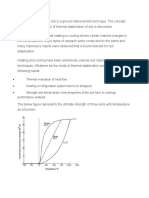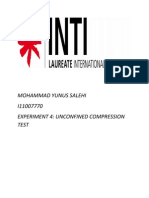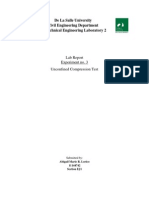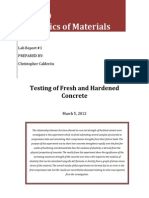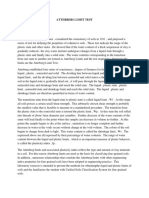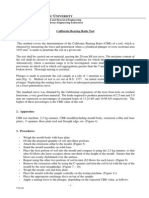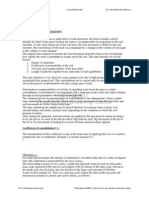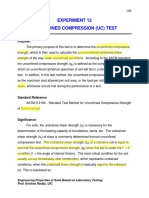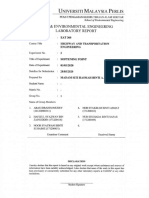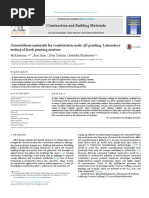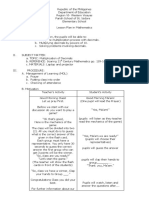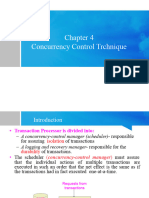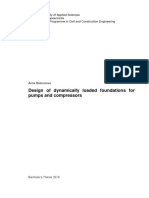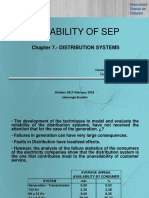Job#4 Unconfined Compressive Strength
Job#4 Unconfined Compressive Strength
Uploaded by
MazharYasinCopyright:
Available Formats
Job#4 Unconfined Compressive Strength
Job#4 Unconfined Compressive Strength
Uploaded by
MazharYasinCopyright
Available Formats
Share this document
Did you find this document useful?
Is this content inappropriate?
Copyright:
Available Formats
Job#4 Unconfined Compressive Strength
Job#4 Unconfined Compressive Strength
Uploaded by
MazharYasinCopyright:
Available Formats
Geotechnical and Foundation Engineering
October 19, 2016
Experiment#4
DETERMINATION OF UNCONFINED COMPRESSIVE
STRENGTH OF COHESIVE SOILS
4.1 OBJECTIVE:
To perform unconfined compression test on cohesive soils to determine their
unconfined compressive strength (qu) and undrained shear strength (Su).
For soils, the undrained shear strength (Su) is necessary for the determination
of the bearing capacity of foundations, dams, etc.
This test method provides an approximate value of the strength of cohesive
soils in terms of total stresses.
4.2 APPARATUS
Unconfined Compression Device
(Electrically driven strain controlled)
Re-molding Device
Deformation Dial Gage
Balance (L.C. = 0.01 gm)
Spatula
Moisture tins
4.3 RELATED THEORY:
The unconfined compression test is by far the most popular method of soil shear
testing because it is one of the fastest and cheapest methods of measuring shear
strength. The method is used primarily for saturated, cohesive soils recovered from
thin-walled sampling tubes. The unconfined compression test is inappropriate for dry
sands or crumbly clays because the materials would fall apart without some land of
lateral confinement.
4.3.1 UNCONFINED COMPRESSIVE STRENGTH OF COHESIVE SOIL:
Unconfined compressive strength of cohesive soil, qu, is defined as the load per unit
area at which an unconfined cylindrical specimen of soil will fail in a simple
compression test.
It is taken as the maximum load attained per unit area or the load per unit area at 15%
axial strain, whichever is secured first during the performance of a test.
The University of Lahore
21
Geotechnical and Foundation Engineering
October 19, 2016
The unconfined compression test is perhaps the simplest, easiest and least expensive
test for investigation of the shear strength of a cohesive soil. This test procedure is
usually limited to cohesive soils, since there is no lateral support and the soil sample
must be able to stand alone. A non-cohesive soil (such as sand) cannot generally
stand alone in this manner without lateral support. The cohesion C is taken to be onehalf the unconfined compressive strength (i.e., C = qu/2).
A cohesive soil gets most of its shear strength from its cohesion. Hence, for most
cohesive soils, the cohesion (and therefore the shear strength) maybe estimated from
the results of unconfined compression test. However, for soft and/or sensitive clay, the
cohesion is commonly obtained instead from the results of field or laboratory vane
tests.
This compression is based on the fact that the minor principal stress ( = zero)
(atmospheric), and the angle of internal friction of the soil is assumed zero. To give
the unconfined compression test more dignity, it is often called an un-drained or U
test. With more knowledge concerning soil behavior available, it became evident that
the unconfined compression test does not generally provide a very reliable value of
soil shear strength for at least three reasons.
The effect of lateral restraint provided by the surrounding soil mass on the
sample is lost when the sample is removed from the ground. There is, however,
some opinion that the soil moisture provides a surface tension (or confining)
effect so that the sample is somewhat confined. This effect should be more
pronounced if the sample is saturated or nearly so. This effect will depend on
the relative humidity of the testing area, making a quantitative evaluation of it
rather difficult.
The internal soil conditions like degree of saturation, the pore water pressure
under stress deformation and the effects of altering the degree of saturation)
cannot be controlled.
The friction on the ends of the sample from the loading platens provides a lateral
restraint on the ends which alters the internal stresses by an unknown amount.
Errors from the first two factors cited above can be eliminated or at least reduced by
using the confined (or tri-axial) compression tests. The third term has undergone
considerable research and the indication is that this factor is not as important as one
might at first suppose.
Special end plates or platens can be fabricated to reduce the friction effects if more
refined test results are desired.
The University of Lahore
22
Geotechnical and Foundation Engineering
October 19, 2016
4.3.2 LIMITATIONS:
The test has been found to be somewhat sensitive to the rate of strain, but a
strain rate between and 2 percent/min appears to yield satisfactory results.
Since the unconfined compression test specimens are exposed to the usually
dry laboratory air (low humidity), specimen should reach failure within about
min; otherwise, the change in water content may affect the unconfined
compressive strength (increase it, usually).
The length to diameter ratio of the test specimens should be large enough to
avoid interference of potential 45 failure planes and short enough that we do
not obtain a Column failure. The length/diameter ratio to satisfy this criterion
is 2 < L/d < 3.
4.3.3 AREA CORRECTION
It is conventional practice in soil mechanics to correct the area on which the load P
is acting. The original area is corrected by considering that the total volume of the soil
is unchanged. The initial total soil sample volume is
Total Volume=
But after some change in specimen length of L
=
Equating both equations for corrected area A we obtain,
)
=
By solving we get
Where
= Corrected Area
= Total Area
Strain= =
The University of Lahore
23
Geotechnical and Foundation Engineering
October 19, 2016
4.4 PROCEDURE:
If density and moisture content of the soil is known, calculate the weight of the
dry soil needed for preparation of three soil samples of 1.5 diameter and 3
height.
Add specified moisture to the dry soil and mix thoroughly. Put some of the soil
for moisture content determination.
4.4.1 PREPARATION OF SAMPLE
We have pressure at sample
= 18
= 11 %
Volume =
Volume =
3 = 5.3014
=0.0000868 m3
W o =180.0000868 = 1.56
= 160
= 1600.11 = 17.6
= 160 17.6 = 142.4
Prepare three soil samples of required density by packing the soil in the
specimen mold.
If the sample specimen crumbles easily or a good bearing surface for the plate
cannot be obtained. It is permissible to cap the end using Plaster of Paris.
If evaporation from the soil is expected, the samples should be sealed by
encapsulating the specimens in a thin latex membrane immediately following
specimens preparation.
Carefully align the specimen in the compression machine.
Set the load dial gage to zero and set the deformation dial to zero. At this time
a very small load should be on the sample (order of ideal 1 unit of a loading
gage).
Turn on machine and take load and deformation dial readings as follows 10,
20, 30, 40, 50 divisions thereafter, until of the following:
The University of Lahore
24
Geotechnical and Foundation Engineering
I.
Load decreases on sample significantly.
II.
Load holds constant for 4 readings.
III.
Deformation is significantly past 15% strain.
October 19, 2016
Remove the specimen from compression machine and sketch the failed
specimen. If an obvious failure plane is observed, measure the angle of the
failure plane with respect to the horizontal and record this angle as .
Determine the water content of the sample.
Test at least two more samples by repeating steps 6 to 10.
Compute the unit strain, corrected area, and the unit stress, for all readings to
define the stress-strain curve adequately. Plot the results on the graph paper
from the test results, show qu as the peak stress of each test and calculate the
average value of qu for three tests. Be sure to plot strain as the abscissa.
Draw a Mohrs Circle using average qu and draw three circles for three
specimens and measure cohesion factor.
The University of Lahore
25
Geotechnical and Foundation Engineering
October 19, 2016
4.5 OBSERVATIONS& CALCULATIONS
Height of specimen=
= 3" = 76.2
Diameter of specimen=
= 1.5" = 38.1
Area of specimen
=
38.1
4
= 1140
Volume of Specimen=AreaHeight= 114076.2
= 86875
Proving Ring Constant= PRC = 0.8 lb/div.
Deformation dial gage constant=0.01 mm
Weight of soil sample= 160 gram
Initial Moisture Content= 11 %
4.5.1 CALCULATIONS
Sr#
1
2
3
4
5
6
7
8
9
10
11
12
13
14
15
16
17
18
Deformation
Dial Gauge
Reading
0.00
10.00
20.00
30.00
40.00
50.00
60.00
70.00
80.00
90.00
100.00
110.00
120.00
130.00
140.00
150.00
160.00
170.00
Load Dial
Gauge
Reading
lb./Div.
0.00
4.00
7.00
10.00
12.00
14.00
16.00
18.00
19.00
20.00
21.00
20.00
19.00
18.00
17.00
16.00
15.00
14.00
The University of Lahore
Sample
Deformation
Unit
Strain
Axial
Strain
Corrected
Area
mm
0.00
0.10
0.20
0.30
0.40
0.50
0.60
0.70
0.80
0.90
1.00
1.10
1.20
1.30
1.40
1.50
1.60
1.70
mm/mm
%
0.00
0.13
0.26
0.39
0.52
0.66
0.79
0.92
1.05
1.18
1.31
1.44
1.57
1.71
1.84
1.97
2.10
2.23
mm2
1140.00
1141.50
1143.00
1144.51
1146.02
1147.53
1149.05
1150.57
1152.10
1153.63
1155.16
1156.70
1158.24
1159.79
1161.34
1162.89
1164.45
1166.01
0.00
0.00
0.00
0.00
0.01
0.01
0.01
0.01
0.01
0.01
0.01
0.01
0.02
0.02
0.02
0.02
0.02
0.02
Axial Load
Axial
Stress
lb.
kN
kPa
0.00
3.20
5.60
8.00
9.60
11.20
12.80
14.40
15.20
16.00
16.80
16.00
15.20
14.40
13.60
12.80
12.00
11.20
0.00
0.01
0.02
0.04
0.04
0.05
0.06
0.06
0.07
0.07
0.07
0.07
0.07
0.06
0.06
0.06
0.05
0.05
0.00
12.47
21.79
31.09
37.26
43.42
49.55
55.67
58.69
61.69
64.69
61.53
58.38
55.23
52.09
48.96
45.84
42.73
26
Geotechnical and Foundation Engineering
October 19, 2016
4.5.2 Graphs
Graph between Axial Stress vs Axial Strain
Axial Stress vs Axial Strain
70.00
qu =64.69 Kpa
60.00
Axial Stress (Kpa)
50.00
40.00
30.00
20.00
10.00
0.00
0.00
0.50
1.00
1.50
2.00
2.50
Axial Strain (%)
Shear Stress
Graph between normal stress and shear stress
=0
C=
3 =0
1 =
Normal Stress
=64.69 Kpa
The University of Lahore
27
Geotechnical and Foundation Engineering
October 19, 2016
4.6 RESULTS
=64.69 kPa
(From graph)
Su = Cu =
= 32.34
Plot the Mohrs circle between normal stress and shear stress and obtain
corresponding undrained shear strength Su of cohesive soil.
4.7 REFERENCE
ASTM D2166-06
Standard Test Method for Unconfined Compressive Strength of Cohesive Soil
4.8 COMMENTS
The primary purpose of this test is to determine the unconfined compressive strength,
which is then used to calculate the unconsolidated undrained shear strength of the
clay under unconfined conditions.
In this experiment, the unconfined compressive strength is taken as the maximum load
attained per unit area, or the load per unit area at 15% axial strain, whichever occurs
first during the performance of a test.
This test can be performed on both types of sample i.e. (Disturbed and Undisturbed)
the strength of the material can be determined. This method of determining strength
is suitable only for soils that can retain a stable specimen shape in the remoulded
state. For soils that will not retain a stable shape, a vane shear test is performed.
The University of Lahore
28
You might also like
- Unconfined Compression TestDocument15 pagesUnconfined Compression TestTeo Peng Keat71% (17)
- Lab 2Document8 pagesLab 2Flonja ShytiNo ratings yet
- Thermal Stabilization of Soil Is A Ground Improvement TechniqueDocument5 pagesThermal Stabilization of Soil Is A Ground Improvement TechniqueBiswajit AcharyaNo ratings yet
- Unconfined CompressionDocument3 pagesUnconfined CompressionAhmadGhanem100% (1)
- One Dimensional Consolidation TestDocument5 pagesOne Dimensional Consolidation TestAzaz AhmedNo ratings yet
- Hydrogen As An Alternative FuelDocument6 pagesHydrogen As An Alternative FuelPurna Satria NugrahaNo ratings yet
- FisikaaDocument3 pagesFisikaa1931 Angeli SamanthaNo ratings yet
- Lisec Glass Cutting Table Machine Retrofit - Saint GobainDocument1 pageLisec Glass Cutting Table Machine Retrofit - Saint GobaineacondeNo ratings yet
- UU Test ReportDocument4 pagesUU Test ReportSharunieRavikumar33% (3)
- Mohammad Yunus Salehi I11007770 Experiment 4: Unconfined Compression TestDocument6 pagesMohammad Yunus Salehi I11007770 Experiment 4: Unconfined Compression TestMohammad Yunus Salehi75% (4)
- Unconfined Compression TestDocument11 pagesUnconfined Compression TestAmiruddin JSNo ratings yet
- CE 3A03 - Geotechnical Engineering I: Lab Instructions Lab 1: Compaction Test 1. ObjectiveDocument4 pagesCE 3A03 - Geotechnical Engineering I: Lab Instructions Lab 1: Compaction Test 1. ObjectivefostbarrNo ratings yet
- 1 Laboratory Compaction Test of SoilDocument11 pages1 Laboratory Compaction Test of SoilAnonymous 0blYQJa0KNo ratings yet
- Compaction TestDocument4 pagesCompaction Testmira asyafNo ratings yet
- Liquid and Plastic LimitDocument13 pagesLiquid and Plastic LimitDariusAngelitoNo ratings yet
- Unconfined Compression Tests PDFDocument6 pagesUnconfined Compression Tests PDFHansen A JamesNo ratings yet
- Unconfined Compression TestDocument4 pagesUnconfined Compression TestRajat KotwalNo ratings yet
- Unconfined Compression TestDocument6 pagesUnconfined Compression TestBahaaAbdalkareemNo ratings yet
- Unconfined CompressiveDocument1 pageUnconfined CompressiveThien ChauNo ratings yet
- Triaxial TestDocument13 pagesTriaxial TestB S Praveen BspNo ratings yet
- Direct Shear TestDocument4 pagesDirect Shear TestanasNo ratings yet
- Triaxial Compression TestDocument3 pagesTriaxial Compression TestNtsika SokasiNo ratings yet
- Lab Direct Shear Test - NewDocument5 pagesLab Direct Shear Test - NewLaBuHiTamNo ratings yet
- Lab 3: Atterberg Limits CE 340Document8 pagesLab 3: Atterberg Limits CE 340satyam agarwal100% (1)
- Specific Gravity of Soil SolidsDocument5 pagesSpecific Gravity of Soil Solidsah maNo ratings yet
- Unconfined Compression TestDocument5 pagesUnconfined Compression TestAbigail Lorico100% (2)
- Exp-6 Permeability by Varying HeadDocument12 pagesExp-6 Permeability by Varying HeadanonymousNo ratings yet
- Permiability Test Aim of The ExperimentDocument7 pagesPermiability Test Aim of The ExperimentArif AzizanNo ratings yet
- Direct Shear TestDocument14 pagesDirect Shear TestAmin SaufiNo ratings yet
- Consolidation TestDocument8 pagesConsolidation TestCasper da MagnificientNo ratings yet
- Vane Shear TestDocument14 pagesVane Shear TestJohn HowardNo ratings yet
- LAB 4 - Undrained Triaxial TestDocument8 pagesLAB 4 - Undrained Triaxial TestAinur NasuhaNo ratings yet
- 16-Suitability of Cohesionless Soil As A HighwayDocument6 pages16-Suitability of Cohesionless Soil As A HighwayRyanYuNo ratings yet
- Sieve Analysis ProcedureDocument0 pagesSieve Analysis ProcedureAbdul Raheem U LNo ratings yet
- Triaxial Test SystemsDocument9 pagesTriaxial Test SystemsAfifah FauziNo ratings yet
- 3.0 Determination of Liquid Limit Using The Cone PenetrometerDocument10 pages3.0 Determination of Liquid Limit Using The Cone PenetrometerasNo ratings yet
- Conclusion Soil CompactionDocument1 pageConclusion Soil Compactionlisther t. juyadNo ratings yet
- CVE 230. Lab Report 1 (Fresh and Hardened Concrete) .Document4 pagesCVE 230. Lab Report 1 (Fresh and Hardened Concrete) .Juan VillaNo ratings yet
- One Dimensional ConsolidationDocument15 pagesOne Dimensional Consolidationmperelmuter0% (1)
- Lecture 8 Soil Compaction 2Document26 pagesLecture 8 Soil Compaction 2BruhNo ratings yet
- Compaction ReportDocument6 pagesCompaction ReportharinderNo ratings yet
- Exp-4 GrainSizeDistribution PDFDocument14 pagesExp-4 GrainSizeDistribution PDFsriknta sahuNo ratings yet
- Determination of The Permeability of Granular SoilDocument19 pagesDetermination of The Permeability of Granular SoilKaluki Judy Rosebell100% (1)
- Atterberg Limit TestDocument10 pagesAtterberg Limit TestshuhadaNo ratings yet
- Proctor Compaction TestDocument8 pagesProctor Compaction TestIreneNo ratings yet
- CBR LabDocument6 pagesCBR LabKaLeung ChungNo ratings yet
- 4 Unconfined CompressionDocument12 pages4 Unconfined CompressionShoaib Alam100% (1)
- Plastic Limit TestDocument9 pagesPlastic Limit TestWilmer FernandezNo ratings yet
- Consolidation TestDocument4 pagesConsolidation TestrbhavishNo ratings yet
- Experiment 12 Unconfined Compression (Uc) Test: PurposeDocument13 pagesExperiment 12 Unconfined Compression (Uc) Test: PurposeKent Aldwin MangalinoNo ratings yet
- AgtDocument7 pagesAgtVijay KulkarniNo ratings yet
- Penetration of Bituminous PDFDocument8 pagesPenetration of Bituminous PDFMaslisa AffenddyNo ratings yet
- Softening Point of Bitumen: Laboratory - Pavement MaterialsDocument4 pagesSoftening Point of Bitumen: Laboratory - Pavement MaterialsJad Louis33% (3)
- Consolidation LabDocument5 pagesConsolidation LabfostbarrNo ratings yet
- Introduction To Geotechnical Engineering: MohammadDocument43 pagesIntroduction To Geotechnical Engineering: MohammadAadolf ElÿasNo ratings yet
- Lab Report Softeing Point G1Document7 pagesLab Report Softeing Point G1Zak HeroNo ratings yet
- LAB 5 Permeability TestDocument9 pagesLAB 5 Permeability TestHanis RahamanNo ratings yet
- Triaxial Test Report - Group 2Document20 pagesTriaxial Test Report - Group 2Khalidah RosmanNo ratings yet
- Prak Tiku MTR I AxialDocument10 pagesPrak Tiku MTR I AxialPatricia EvelynNo ratings yet
- Consolidation Test - (Oedometer Test)Document8 pagesConsolidation Test - (Oedometer Test)saleem razaNo ratings yet
- Geo TechnicalDocument16 pagesGeo TechnicalAyush GorasiyaNo ratings yet
- CE 154 Foundation Engineering Topic 1d ContinuationDocument7 pagesCE 154 Foundation Engineering Topic 1d ContinuationJim Kenneth MadronalNo ratings yet
- MohrDocument12 pagesMohrJoseph JboyNo ratings yet
- Lecture 1 & 2: Construction ProjectsDocument19 pagesLecture 1 & 2: Construction ProjectsMazharYasinNo ratings yet
- Drawing Lecture-1Document28 pagesDrawing Lecture-1MazharYasinNo ratings yet
- Construction and Building MaterialsDocument9 pagesConstruction and Building MaterialsMazharYasinNo ratings yet
- SBR LatexDocument2 pagesSBR LatexMazharYasinNo ratings yet
- Hot Weather ConcretingDocument6 pagesHot Weather ConcretingMazharYasinNo ratings yet
- CementDocument12 pagesCementMazharYasinNo ratings yet
- Uol HRD EdifDocument1 pageUol HRD EdifMazharYasinNo ratings yet
- Experiment No. 10: To Determine The Effect of Rate of Loading On The Compressive Strength of P.C.C Cube and CylinderDocument3 pagesExperiment No. 10: To Determine The Effect of Rate of Loading On The Compressive Strength of P.C.C Cube and CylinderMazharYasinNo ratings yet
- Brick BondsDocument4 pagesBrick BondsMazharYasinNo ratings yet
- Structurepoint - Spcolumn V5.50 (TM) - 1869762670 Day Trial License. Locking Code: 4-31D37. User: Mazhar Yasin, MsceDocument1 pageStructurepoint - Spcolumn V5.50 (TM) - 1869762670 Day Trial License. Locking Code: 4-31D37. User: Mazhar Yasin, MsceMazharYasinNo ratings yet
- Structurepoint - Spcolumn V5.50 (TM) - 1869762670 Day Trial License. Locking Code: 4-31D37. User: Mazhar Yasin, MsceDocument1 pageStructurepoint - Spcolumn V5.50 (TM) - 1869762670 Day Trial License. Locking Code: 4-31D37. User: Mazhar Yasin, MsceMazharYasinNo ratings yet
- Table: Assembled Joint Masses Joint Masssource U1 U2 U3 R1 R2 R3 CenterxDocument80 pagesTable: Assembled Joint Masses Joint Masssource U1 U2 U3 R1 R2 R3 CenterxMazharYasinNo ratings yet
- GRE+GAT WORD LIST (Edited)Document442 pagesGRE+GAT WORD LIST (Edited)MazharYasinNo ratings yet
- SP ColumnDocument2 pagesSP ColumnMazharYasinNo ratings yet
- SDOF Damped Forced Vibration - NewmarkDocument5 pagesSDOF Damped Forced Vibration - NewmarkMazharYasinNo ratings yet
- Cacat KristalDocument12 pagesCacat KristalBudi IstanaNo ratings yet
- Factors Affecting Rate of Chemical Reaction ACtivity SheetDocument4 pagesFactors Affecting Rate of Chemical Reaction ACtivity SheetRazel MontañezNo ratings yet
- Kinematics (Theory) FinalDocument35 pagesKinematics (Theory) FinalAbhishekha Chandra DubeyNo ratings yet
- Окръжност и ъгълDocument13 pagesОкръжност и ъгълkalindimov322No ratings yet
- Grade 1 Mathematics Concept Book 10 © COPYRIGHTDocument34 pagesGrade 1 Mathematics Concept Book 10 © COPYRIGHTthobilemtsweni61No ratings yet
- Electron ConfigurationDocument28 pagesElectron ConfigurationEbb Edel QuibodNo ratings yet
- OOCP Practical List 2017Document5 pagesOOCP Practical List 2017masumiNo ratings yet
- From Protein Structure To Function With Bioinformatics (PDFDrive)Document509 pagesFrom Protein Structure To Function With Bioinformatics (PDFDrive)ירדן לוין100% (1)
- Timken Practical Data For Metallurgists HandbookDocument120 pagesTimken Practical Data For Metallurgists Handbookjuliocr79No ratings yet
- Clarification of Cane MolassesDocument88 pagesClarification of Cane MolassesISICA ISICANo ratings yet
- Simulation TechniquesDocument2 pagesSimulation TechniquesPooja GuptaNo ratings yet
- Math Lesson PlanDocument4 pagesMath Lesson PlanMary Grace D. BadolesNo ratings yet
- Tia-644-A Electrical Characteristics of Low Voltage Differential Signaling (LVDS) Interface CircuitsDocument36 pagesTia-644-A Electrical Characteristics of Low Voltage Differential Signaling (LVDS) Interface Circuitsmfnandes.monteiroNo ratings yet
- DTR Form 48Document1 pageDTR Form 48Kanval ButtNo ratings yet
- Fluoride PDFDocument7 pagesFluoride PDFevin34No ratings yet
- MAQUINAS DE ACIONAMENTO WZH 21 209 72dpi enDocument100 pagesMAQUINAS DE ACIONAMENTO WZH 21 209 72dpi enToniase Guimaraes BarrosNo ratings yet
- 2 - 10-Design of Voice Control Robot and Breakdown AnalysisDocument53 pages2 - 10-Design of Voice Control Robot and Breakdown AnalysisChirag ThakurNo ratings yet
- Notes: Artificial Intelligence (Msc/Mca)Document49 pagesNotes: Artificial Intelligence (Msc/Mca)gouthamk5151No ratings yet
- Canonical Cover of Functional Dependency DBMSDocument15 pagesCanonical Cover of Functional Dependency DBMSnissy jessilynNo ratings yet
- Chapter 4 Concurrency ControlDocument38 pagesChapter 4 Concurrency Controlsurafel123emiruNo ratings yet
- Design of Dynamically Loaded Foundations For Pumps and Compressors-Belovolova - ArinaDocument38 pagesDesign of Dynamically Loaded Foundations For Pumps and Compressors-Belovolova - ArinaAmrut Bhatt100% (1)
- RCC Design of SlabDocument9 pagesRCC Design of Slabmirshoaib954No ratings yet
- Solar Vector Solving Method Based On PhotovoltaicDocument13 pagesSolar Vector Solving Method Based On PhotovoltaicperelapelNo ratings yet
- Soal LatihanDocument5 pagesSoal Latihanjasmine dhillonNo ratings yet
- 1.voice Leading ArpeggiosDocument4 pages1.voice Leading ArpeggiosJan FunkygoodTimeNo ratings yet
- Reliability of Sep: Chapter 7.-Distribution SystemsDocument24 pagesReliability of Sep: Chapter 7.-Distribution SystemsFranklin PardoNo ratings yet
- Sceregvl InfDocument6 pagesSceregvl InfsenrikNo ratings yet


